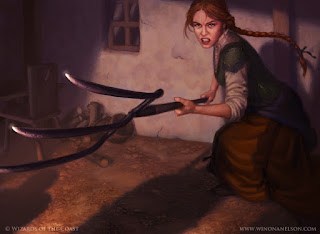Encumbrance is probably the least used and most boring part of RPGs. I don’t think I’ve ever been a player in a game where encumbrance was ever an issue that really came up, as most games use complicated systems that suck the fun right out of the game, so no one ever bothers with them. Or they use a system based on Strength and how much you can lift and nothing else, making it silly and unrealistic. Castles & Crusades, at least in the 4th printing that I own, has a terribly convoluted and dare-I-say-it unplayable encumbrance system. I knew when I started this that it would be the very first thing I scrapped from the system.
Encumbrance doesn’t have to be so crappy, though.
Lamentations of the Flame Princess was the first game I ever played that had an encumbrance system that wasn’t terrible and was simple to implement.
So I’m porting that into this game.
In LotFP, you can carry any number of items. However, the more you carry, the more Encumbrance Points you accrue. It uses a system of equipment slots. Every sixth slot you fill grants an encumbrance point. Small items, like an arrow, can have many carried before filling a slot. Certain types of armor automatically count for encumbrance points.
Having so many encumbrance points affects your speed and, in the case of Magic Users, your ability to cast spells.
While Encumbrance doesn’t have to be continually tracked throughout play, the Referee is allowed to audit a player’s equipment at any time, with the player penalized accordingly if they are carrying too much stuff.
Add to this the importance LotFP places on hiring retainers, and it’s a very effective and simple system.
In a nutshell;
- Carrying 6 or more items is a point.
- Carrying 11 or more items is two points.
- Carrying 16 or more items is three points.
- Carrying 21 or more items is four points.
- Oversized items, two-handed weapons, some armor = 1 point.
- Giant sized items, some armor = 2 points
- More on armor and how it affects encumbrance in the next post.
Lamentations of the Flame Princess, though, is designed for a more gritty, low-fantasy, setting. Not the high-fantasy, ridiculousness of Strathos. Some some changes are necessary.
- Constitution Modifier applies to Encumbrance. This means that you receive extra item slots based on your Con mod, before you take an encumbrance point. On the other hand, having a negative Con mod means you can fill fewer slots before taking an encumbrance point.
Example 1: Sheila the Barbarian has a +2 Con modifier. This translates to her being able to fill 7 slots of items before accruing an encumbrance point.
Example 2: Brxrfrx the Mushroom has no Con modifier. It can fill up to 5 slots of items without accruing an encumbrance point.
Example 3: Trent the Wizard has a -2 Con modifier. He can only fill up to 3 slots of items before accruing an encumbrance point.
Okay, but what does it mean to accrue and Encumbrance Point? How do they affect the game?
- Zero or One encumbrance points = Unencumbered. This has no effect on your character.
- Two encumbrance points = Lightly encumbered. Speed is reduced 20%.
- Three points = Heavily encumbered. Speed is reduced by 40%, and Magic Users cannot use magic. Characters suffer a -1 penalty to all combat rolls and skill checks, as well as dexterity based saves.
- Four points = Severely encumbered. Speed is reduced by 80%. Characters suffer a -3 penalty to all combat rolls, skill checks, and Dexterity based saves.
- 5 points = Overencumbered. The character cannot move.
Example 4: Trent the Wizard is carrying a spell book (1 item slot), a pen and ink set (1 item slot), a dagger (1 item slot), a weeks worth of rations (1 item slot) and a staff (two-handed weapon: 1 encumbrance point), making him Lightly Encumbered. Why? Because he has filled 4 item slots (remember, he can only fill three slots without accruing a point) and has a two-handed weapon. That totals 2 encumbrance points.
While all of this makes sense to me, I know that it doesn’t necessarily make sense to anyone reading this. So I am happy to answer any questions.


























